HI6028 Taxation Theory, Practice and Law Final Assessment T1 2021
VerifiedAdded on 2022/11/25
|6
|1780
|259
Homework Assignment
AI Summary
This assignment solution for HI6028 Taxation Theory, Practice and Law, assesses knowledge of Australian taxation principles. The assignment addresses the circumstances under which individuals and companies are considered Australian residents based on the Income Tax Assessment Act 1936 and relevant case law. It analyzes the allowability of various deductions against assessable income, including doubtful debts, speeding fines, and expenses related to partnership deeds, travel, and newspapers. The solution calculates depreciation using both prime cost and diminishing value methods for machinery and a car. It examines the tax consequences for a partnership and its partners, considering assessable income, deductible expenses, and the distribution of losses. The assignment also addresses capital gains tax (CGT) consequences of asset sales, including collectibles and personal-use assets, and calculates net capital gains or losses. Finally, it defines and provides examples of tax evasion and tax avoidance.
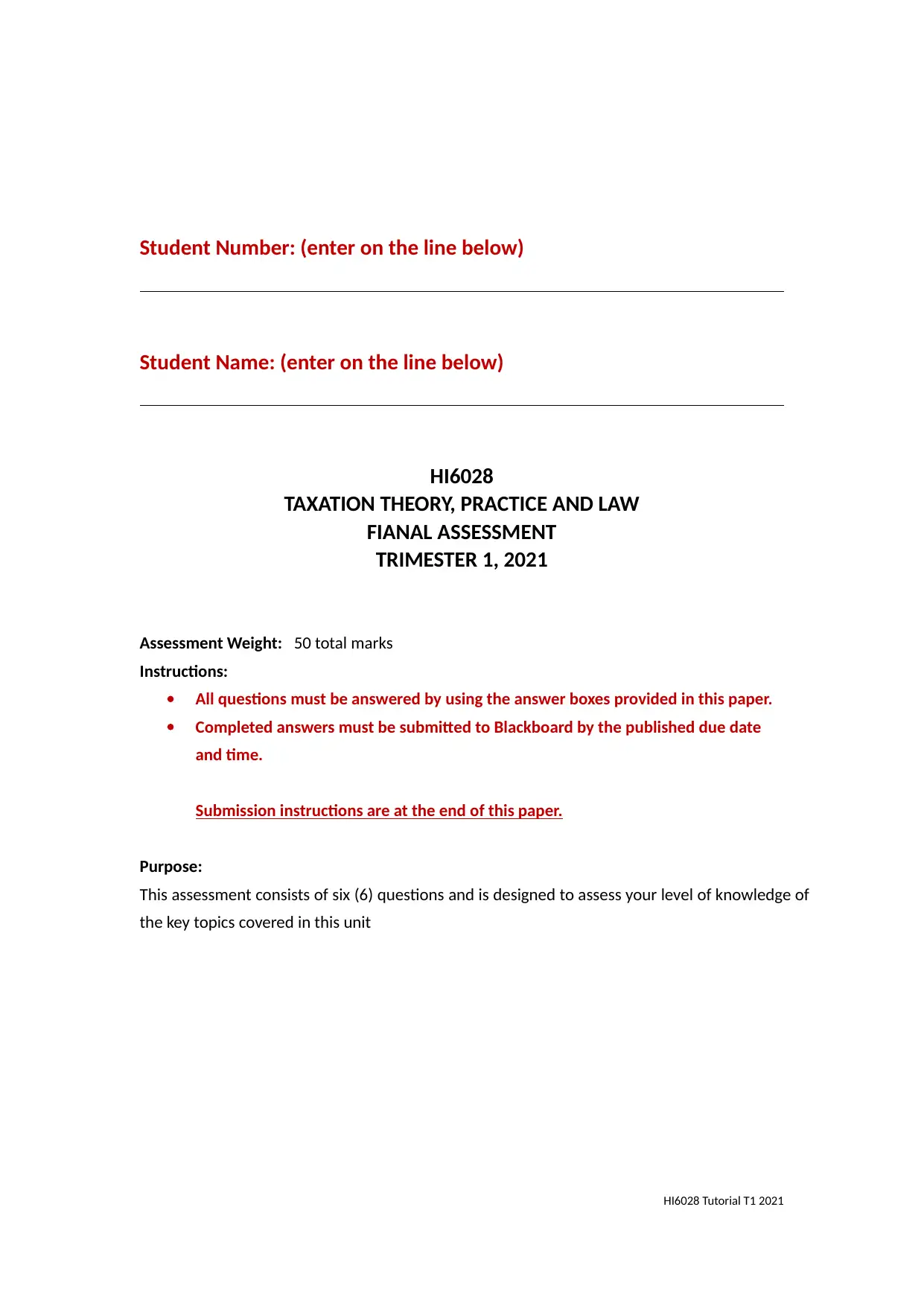
Student Number: (enter on the line below)
Student Name: (enter on the line below)
HI6028
TAXATION THEORY, PRACTICE AND LAW
FIANAL ASSESSMENT
TRIMESTER 1, 2021
Assessment Weight: 50 total marks
Instructions:
All questions must be answered by using the answer boxes provided in this paper.
Completed answers must be submitted to Blackboard by the published due date
and time.
Submission instructions are at the end of this paper.
Purpose:
This assessment consists of six (6) questions and is designed to assess your level of knowledge of
the key topics covered in this unit
HI6028 Tutorial T1 2021
Student Name: (enter on the line below)
HI6028
TAXATION THEORY, PRACTICE AND LAW
FIANAL ASSESSMENT
TRIMESTER 1, 2021
Assessment Weight: 50 total marks
Instructions:
All questions must be answered by using the answer boxes provided in this paper.
Completed answers must be submitted to Blackboard by the published due date
and time.
Submission instructions are at the end of this paper.
Purpose:
This assessment consists of six (6) questions and is designed to assess your level of knowledge of
the key topics covered in this unit
HI6028 Tutorial T1 2021
Paraphrase This Document
Need a fresh take? Get an instant paraphrase of this document with our AI Paraphraser
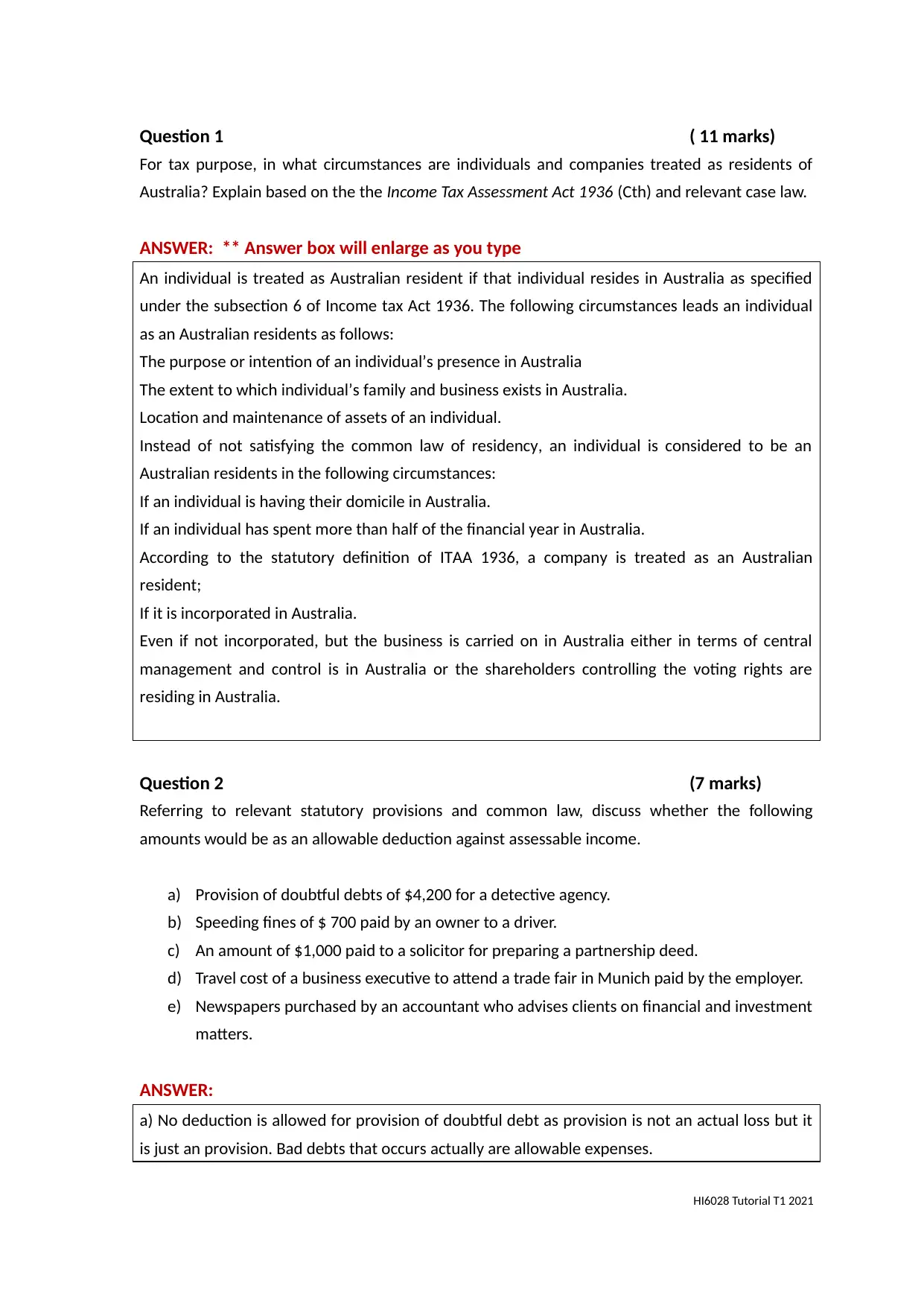
Question 1 ( 11 marks)
For tax purpose, in what circumstances are individuals and companies treated as residents of
Australia? Explain based on the the Income Tax Assessment Act 1936 (Cth) and relevant case law.
ANSWER: ** Answer box will enlarge as you type
An individual is treated as Australian resident if that individual resides in Australia as specified
under the subsection 6 of Income tax Act 1936. The following circumstances leads an individual
as an Australian residents as follows:
The purpose or intention of an individual’s presence in Australia
The extent to which individual’s family and business exists in Australia.
Location and maintenance of assets of an individual.
Instead of not satisfying the common law of residency, an individual is considered to be an
Australian residents in the following circumstances:
If an individual is having their domicile in Australia.
If an individual has spent more than half of the financial year in Australia.
According to the statutory definition of ITAA 1936, a company is treated as an Australian
resident;
If it is incorporated in Australia.
Even if not incorporated, but the business is carried on in Australia either in terms of central
management and control is in Australia or the shareholders controlling the voting rights are
residing in Australia.
Question 2 (7 marks)
Referring to relevant statutory provisions and common law, discuss whether the following
amounts would be as an allowable deduction against assessable income.
a) Provision of doubtful debts of $4,200 for a detective agency.
b) Speeding fines of $ 700 paid by an owner to a driver.
c) An amount of $1,000 paid to a solicitor for preparing a partnership deed.
d) Travel cost of a business executive to attend a trade fair in Munich paid by the employer.
e) Newspapers purchased by an accountant who advises clients on financial and investment
matters.
ANSWER:
a) No deduction is allowed for provision of doubtful debt as provision is not an actual loss but it
is just an provision. Bad debts that occurs actually are allowable expenses.
HI6028 Tutorial T1 2021
For tax purpose, in what circumstances are individuals and companies treated as residents of
Australia? Explain based on the the Income Tax Assessment Act 1936 (Cth) and relevant case law.
ANSWER: ** Answer box will enlarge as you type
An individual is treated as Australian resident if that individual resides in Australia as specified
under the subsection 6 of Income tax Act 1936. The following circumstances leads an individual
as an Australian residents as follows:
The purpose or intention of an individual’s presence in Australia
The extent to which individual’s family and business exists in Australia.
Location and maintenance of assets of an individual.
Instead of not satisfying the common law of residency, an individual is considered to be an
Australian residents in the following circumstances:
If an individual is having their domicile in Australia.
If an individual has spent more than half of the financial year in Australia.
According to the statutory definition of ITAA 1936, a company is treated as an Australian
resident;
If it is incorporated in Australia.
Even if not incorporated, but the business is carried on in Australia either in terms of central
management and control is in Australia or the shareholders controlling the voting rights are
residing in Australia.
Question 2 (7 marks)
Referring to relevant statutory provisions and common law, discuss whether the following
amounts would be as an allowable deduction against assessable income.
a) Provision of doubtful debts of $4,200 for a detective agency.
b) Speeding fines of $ 700 paid by an owner to a driver.
c) An amount of $1,000 paid to a solicitor for preparing a partnership deed.
d) Travel cost of a business executive to attend a trade fair in Munich paid by the employer.
e) Newspapers purchased by an accountant who advises clients on financial and investment
matters.
ANSWER:
a) No deduction is allowed for provision of doubtful debt as provision is not an actual loss but it
is just an provision. Bad debts that occurs actually are allowable expenses.
HI6028 Tutorial T1 2021
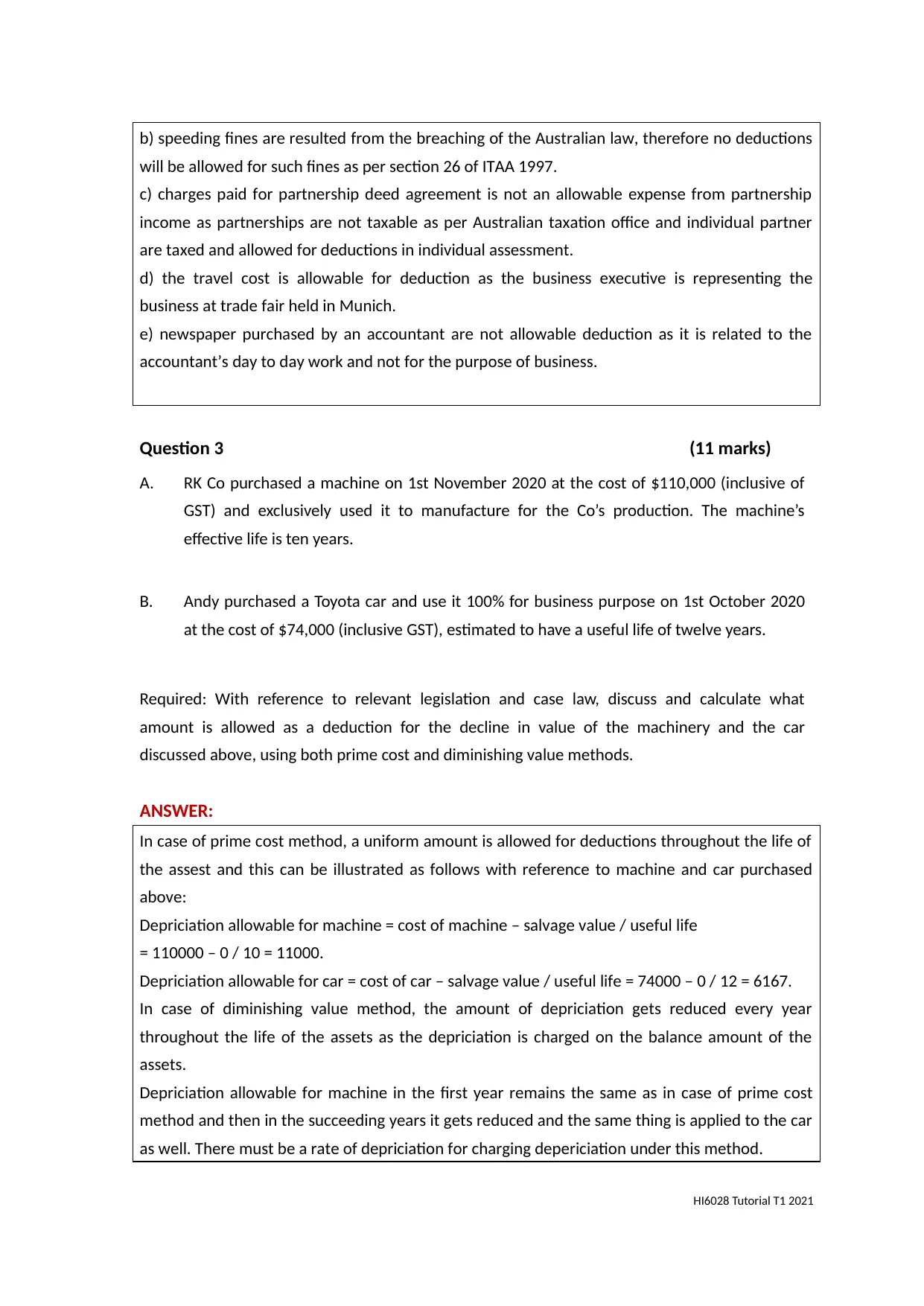
b) speeding fines are resulted from the breaching of the Australian law, therefore no deductions
will be allowed for such fines as per section 26 of ITAA 1997.
c) charges paid for partnership deed agreement is not an allowable expense from partnership
income as partnerships are not taxable as per Australian taxation office and individual partner
are taxed and allowed for deductions in individual assessment.
d) the travel cost is allowable for deduction as the business executive is representing the
business at trade fair held in Munich.
e) newspaper purchased by an accountant are not allowable deduction as it is related to the
accountant’s day to day work and not for the purpose of business.
Question 3 (11 marks)
A. RK Co purchased a machine on 1st November 2020 at the cost of $110,000 (inclusive of
GST) and exclusively used it to manufacture for the Co’s production. The machine’s
effective life is ten years.
B. Andy purchased a Toyota car and use it 100% for business purpose on 1st October 2020
at the cost of $74,000 (inclusive GST), estimated to have a useful life of twelve years.
Required: With reference to relevant legislation and case law, discuss and calculate what
amount is allowed as a deduction for the decline in value of the machinery and the car
discussed above, using both prime cost and diminishing value methods.
ANSWER:
In case of prime cost method, a uniform amount is allowed for deductions throughout the life of
the assest and this can be illustrated as follows with reference to machine and car purchased
above:
Depriciation allowable for machine = cost of machine – salvage value / useful life
= 110000 – 0 / 10 = 11000.
Depriciation allowable for car = cost of car – salvage value / useful life = 74000 – 0 / 12 = 6167.
In case of diminishing value method, the amount of depriciation gets reduced every year
throughout the life of the assets as the depriciation is charged on the balance amount of the
assets.
Depriciation allowable for machine in the first year remains the same as in case of prime cost
method and then in the succeeding years it gets reduced and the same thing is applied to the car
as well. There must be a rate of depriciation for charging depericiation under this method.
HI6028 Tutorial T1 2021
will be allowed for such fines as per section 26 of ITAA 1997.
c) charges paid for partnership deed agreement is not an allowable expense from partnership
income as partnerships are not taxable as per Australian taxation office and individual partner
are taxed and allowed for deductions in individual assessment.
d) the travel cost is allowable for deduction as the business executive is representing the
business at trade fair held in Munich.
e) newspaper purchased by an accountant are not allowable deduction as it is related to the
accountant’s day to day work and not for the purpose of business.
Question 3 (11 marks)
A. RK Co purchased a machine on 1st November 2020 at the cost of $110,000 (inclusive of
GST) and exclusively used it to manufacture for the Co’s production. The machine’s
effective life is ten years.
B. Andy purchased a Toyota car and use it 100% for business purpose on 1st October 2020
at the cost of $74,000 (inclusive GST), estimated to have a useful life of twelve years.
Required: With reference to relevant legislation and case law, discuss and calculate what
amount is allowed as a deduction for the decline in value of the machinery and the car
discussed above, using both prime cost and diminishing value methods.
ANSWER:
In case of prime cost method, a uniform amount is allowed for deductions throughout the life of
the assest and this can be illustrated as follows with reference to machine and car purchased
above:
Depriciation allowable for machine = cost of machine – salvage value / useful life
= 110000 – 0 / 10 = 11000.
Depriciation allowable for car = cost of car – salvage value / useful life = 74000 – 0 / 12 = 6167.
In case of diminishing value method, the amount of depriciation gets reduced every year
throughout the life of the assets as the depriciation is charged on the balance amount of the
assets.
Depriciation allowable for machine in the first year remains the same as in case of prime cost
method and then in the succeeding years it gets reduced and the same thing is applied to the car
as well. There must be a rate of depriciation for charging depericiation under this method.
HI6028 Tutorial T1 2021
⊘ This is a preview!⊘
Do you want full access?
Subscribe today to unlock all pages.

Trusted by 1+ million students worldwide
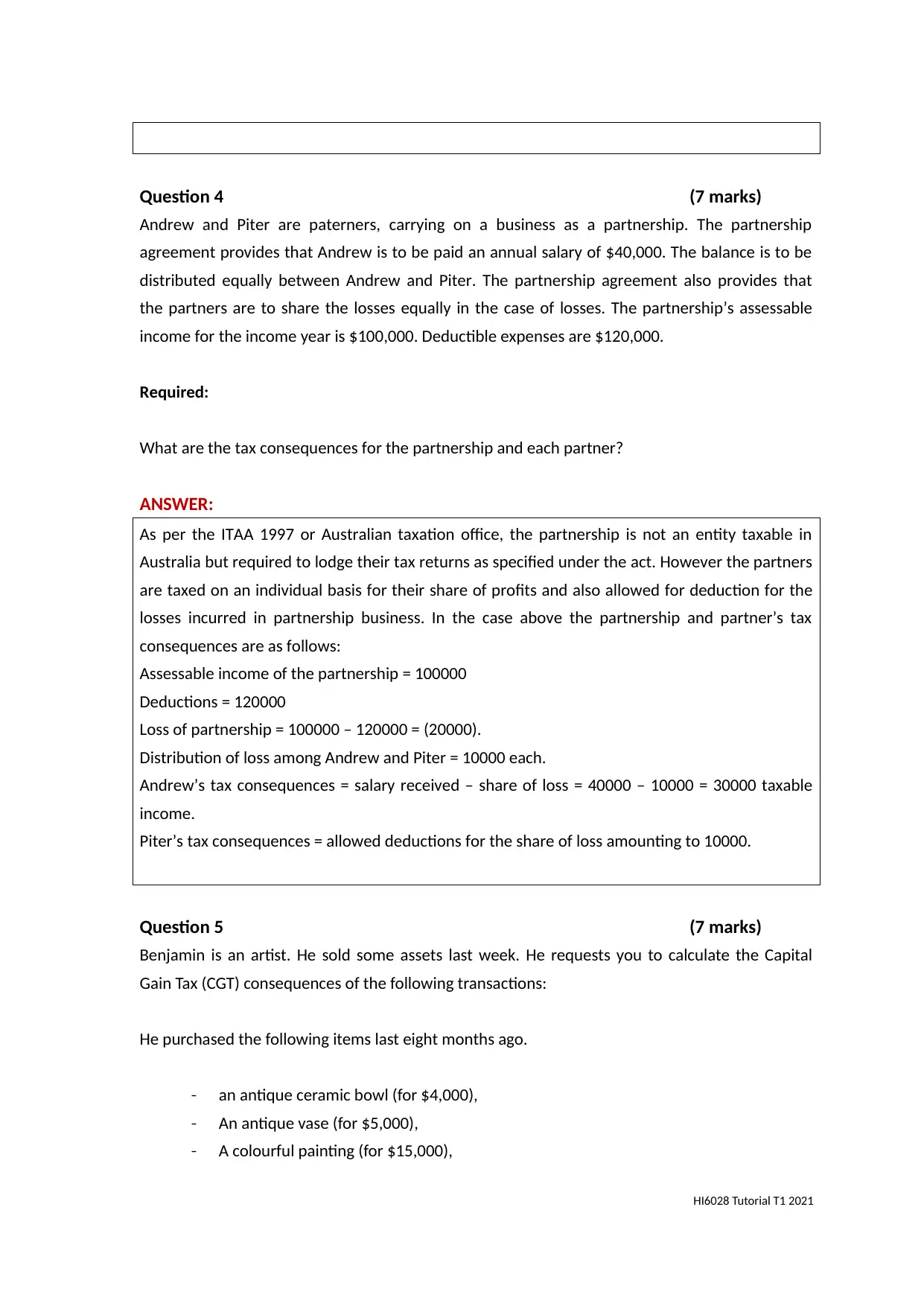
Question 4 (7 marks)
Andrew and Piter are paterners, carrying on a business as a partnership. The partnership
agreement provides that Andrew is to be paid an annual salary of $40,000. The balance is to be
distributed equally between Andrew and Piter. The partnership agreement also provides that
the partners are to share the losses equally in the case of losses. The partnership’s assessable
income for the income year is $100,000. Deductible expenses are $120,000.
Required:
What are the tax consequences for the partnership and each partner?
ANSWER:
As per the ITAA 1997 or Australian taxation office, the partnership is not an entity taxable in
Australia but required to lodge their tax returns as specified under the act. However the partners
are taxed on an individual basis for their share of profits and also allowed for deduction for the
losses incurred in partnership business. In the case above the partnership and partner’s tax
consequences are as follows:
Assessable income of the partnership = 100000
Deductions = 120000
Loss of partnership = 100000 – 120000 = (20000).
Distribution of loss among Andrew and Piter = 10000 each.
Andrew’s tax consequences = salary received – share of loss = 40000 – 10000 = 30000 taxable
income.
Piter’s tax consequences = allowed deductions for the share of loss amounting to 10000.
Question 5 (7 marks)
Benjamin is an artist. He sold some assets last week. He requests you to calculate the Capital
Gain Tax (CGT) consequences of the following transactions:
He purchased the following items last eight months ago.
- an antique ceramic bowl (for $4,000),
- An antique vase (for $5,000),
- A colourful painting (for $15,000),
HI6028 Tutorial T1 2021
Andrew and Piter are paterners, carrying on a business as a partnership. The partnership
agreement provides that Andrew is to be paid an annual salary of $40,000. The balance is to be
distributed equally between Andrew and Piter. The partnership agreement also provides that
the partners are to share the losses equally in the case of losses. The partnership’s assessable
income for the income year is $100,000. Deductible expenses are $120,000.
Required:
What are the tax consequences for the partnership and each partner?
ANSWER:
As per the ITAA 1997 or Australian taxation office, the partnership is not an entity taxable in
Australia but required to lodge their tax returns as specified under the act. However the partners
are taxed on an individual basis for their share of profits and also allowed for deduction for the
losses incurred in partnership business. In the case above the partnership and partner’s tax
consequences are as follows:
Assessable income of the partnership = 100000
Deductions = 120000
Loss of partnership = 100000 – 120000 = (20000).
Distribution of loss among Andrew and Piter = 10000 each.
Andrew’s tax consequences = salary received – share of loss = 40000 – 10000 = 30000 taxable
income.
Piter’s tax consequences = allowed deductions for the share of loss amounting to 10000.
Question 5 (7 marks)
Benjamin is an artist. He sold some assets last week. He requests you to calculate the Capital
Gain Tax (CGT) consequences of the following transactions:
He purchased the following items last eight months ago.
- an antique ceramic bowl (for $4,000),
- An antique vase (for $5,000),
- A colourful painting (for $15,000),
HI6028 Tutorial T1 2021
Paraphrase This Document
Need a fresh take? Get an instant paraphrase of this document with our AI Paraphraser
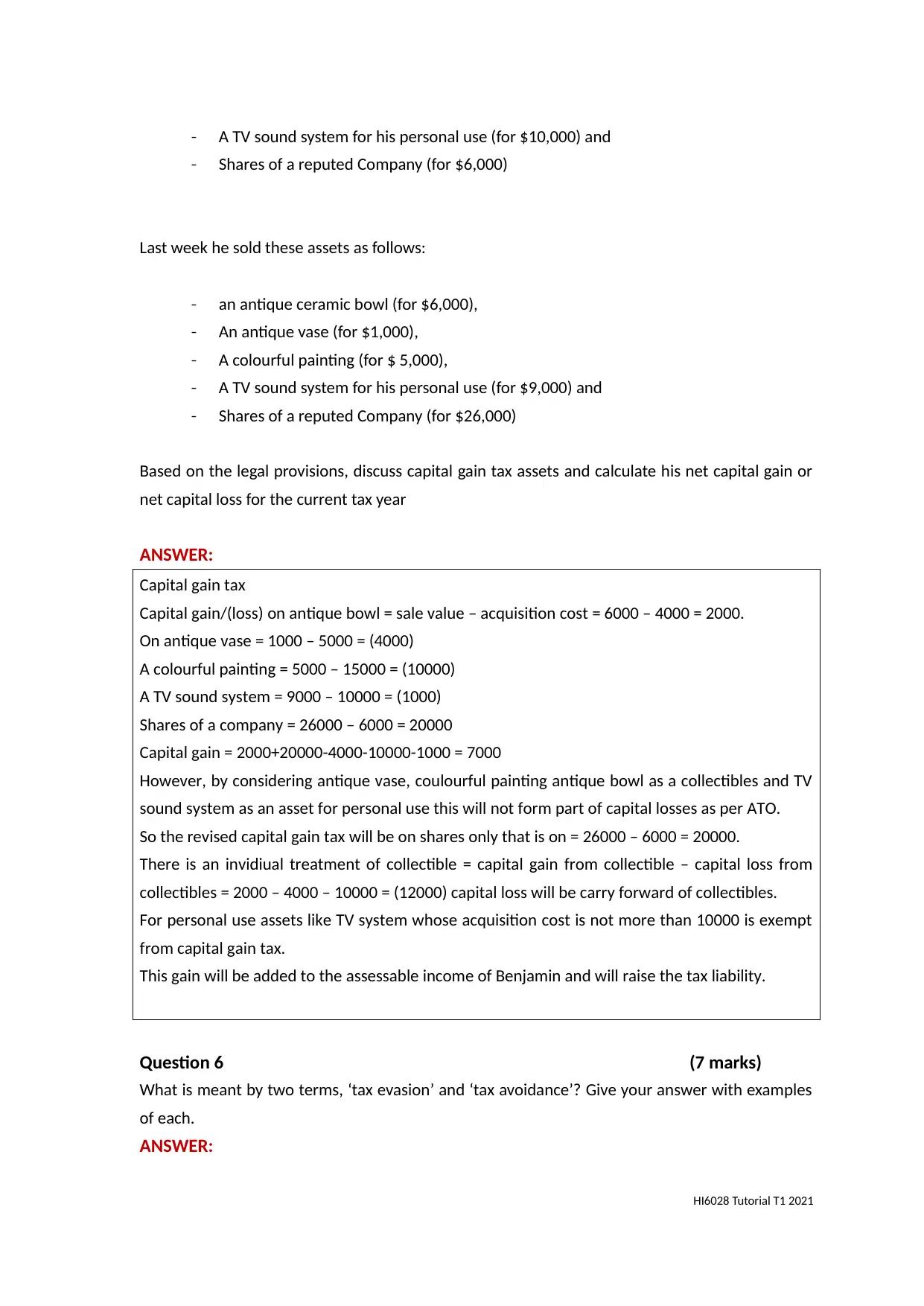
- A TV sound system for his personal use (for $10,000) and
- Shares of a reputed Company (for $6,000)
Last week he sold these assets as follows:
- an antique ceramic bowl (for $6,000),
- An antique vase (for $1,000),
- A colourful painting (for $ 5,000),
- A TV sound system for his personal use (for $9,000) and
- Shares of a reputed Company (for $26,000)
Based on the legal provisions, discuss capital gain tax assets and calculate his net capital gain or
net capital loss for the current tax year
ANSWER:
Capital gain tax
Capital gain/(loss) on antique bowl = sale value – acquisition cost = 6000 – 4000 = 2000.
On antique vase = 1000 – 5000 = (4000)
A colourful painting = 5000 – 15000 = (10000)
A TV sound system = 9000 – 10000 = (1000)
Shares of a company = 26000 – 6000 = 20000
Capital gain = 2000+20000-4000-10000-1000 = 7000
However, by considering antique vase, coulourful painting antique bowl as a collectibles and TV
sound system as an asset for personal use this will not form part of capital losses as per ATO.
So the revised capital gain tax will be on shares only that is on = 26000 – 6000 = 20000.
There is an invidiual treatment of collectible = capital gain from collectible – capital loss from
collectibles = 2000 – 4000 – 10000 = (12000) capital loss will be carry forward of collectibles.
For personal use assets like TV system whose acquisition cost is not more than 10000 is exempt
from capital gain tax.
This gain will be added to the assessable income of Benjamin and will raise the tax liability.
Question 6 (7 marks)
What is meant by two terms, ‘tax evasion’ and ‘tax avoidance’? Give your answer with examples
of each.
ANSWER:
HI6028 Tutorial T1 2021
- Shares of a reputed Company (for $6,000)
Last week he sold these assets as follows:
- an antique ceramic bowl (for $6,000),
- An antique vase (for $1,000),
- A colourful painting (for $ 5,000),
- A TV sound system for his personal use (for $9,000) and
- Shares of a reputed Company (for $26,000)
Based on the legal provisions, discuss capital gain tax assets and calculate his net capital gain or
net capital loss for the current tax year
ANSWER:
Capital gain tax
Capital gain/(loss) on antique bowl = sale value – acquisition cost = 6000 – 4000 = 2000.
On antique vase = 1000 – 5000 = (4000)
A colourful painting = 5000 – 15000 = (10000)
A TV sound system = 9000 – 10000 = (1000)
Shares of a company = 26000 – 6000 = 20000
Capital gain = 2000+20000-4000-10000-1000 = 7000
However, by considering antique vase, coulourful painting antique bowl as a collectibles and TV
sound system as an asset for personal use this will not form part of capital losses as per ATO.
So the revised capital gain tax will be on shares only that is on = 26000 – 6000 = 20000.
There is an invidiual treatment of collectible = capital gain from collectible – capital loss from
collectibles = 2000 – 4000 – 10000 = (12000) capital loss will be carry forward of collectibles.
For personal use assets like TV system whose acquisition cost is not more than 10000 is exempt
from capital gain tax.
This gain will be added to the assessable income of Benjamin and will raise the tax liability.
Question 6 (7 marks)
What is meant by two terms, ‘tax evasion’ and ‘tax avoidance’? Give your answer with examples
of each.
ANSWER:
HI6028 Tutorial T1 2021
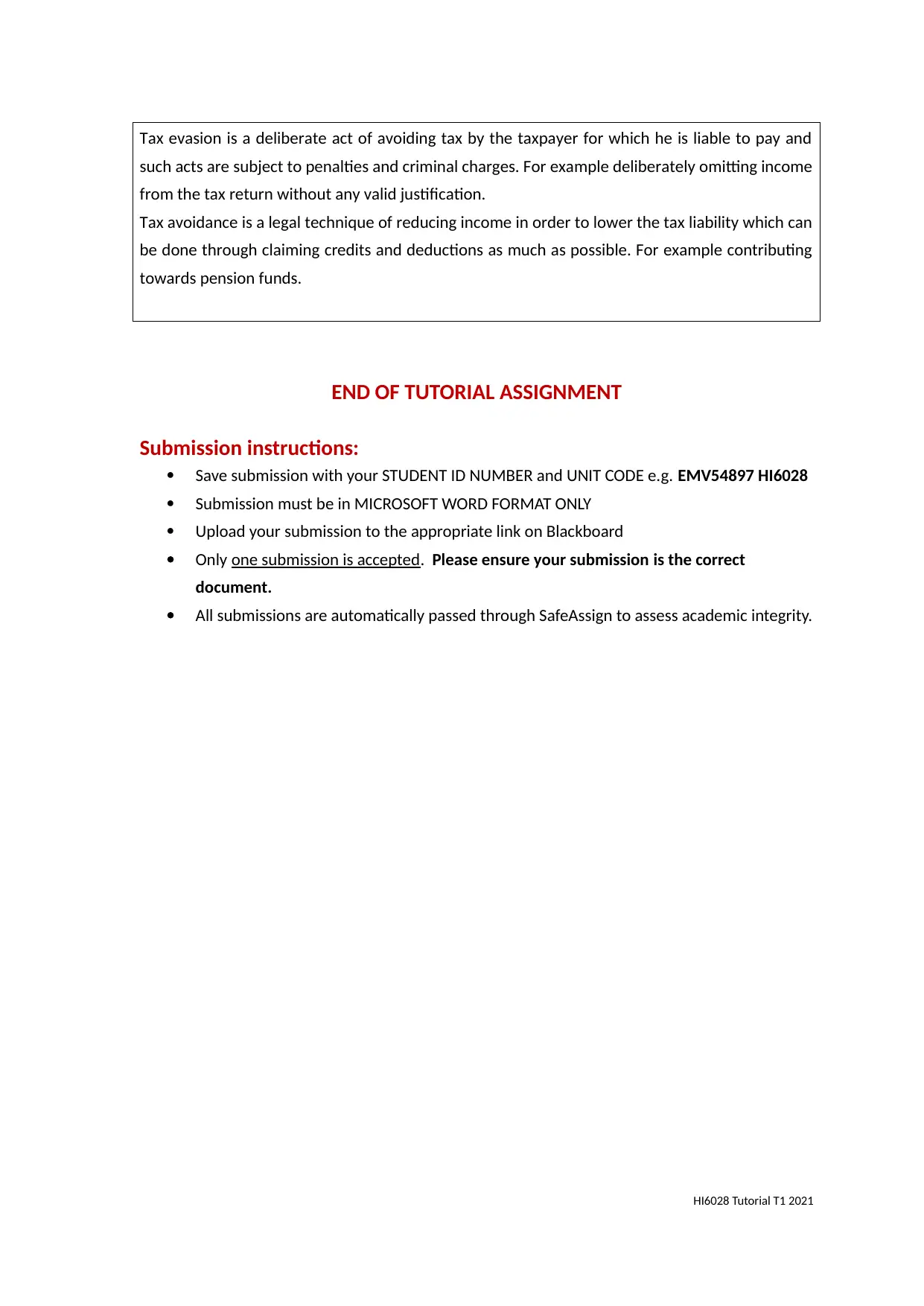
Tax evasion is a deliberate act of avoiding tax by the taxpayer for which he is liable to pay and
such acts are subject to penalties and criminal charges. For example deliberately omitting income
from the tax return without any valid justification.
Tax avoidance is a legal technique of reducing income in order to lower the tax liability which can
be done through claiming credits and deductions as much as possible. For example contributing
towards pension funds.
END OF TUTORIAL ASSIGNMENT
Submission instructions:
Save submission with your STUDENT ID NUMBER and UNIT CODE e.g. EMV54897 HI6028
Submission must be in MICROSOFT WORD FORMAT ONLY
Upload your submission to the appropriate link on Blackboard
Only one submission is accepted. Please ensure your submission is the correct
document.
All submissions are automatically passed through SafeAssign to assess academic integrity.
HI6028 Tutorial T1 2021
such acts are subject to penalties and criminal charges. For example deliberately omitting income
from the tax return without any valid justification.
Tax avoidance is a legal technique of reducing income in order to lower the tax liability which can
be done through claiming credits and deductions as much as possible. For example contributing
towards pension funds.
END OF TUTORIAL ASSIGNMENT
Submission instructions:
Save submission with your STUDENT ID NUMBER and UNIT CODE e.g. EMV54897 HI6028
Submission must be in MICROSOFT WORD FORMAT ONLY
Upload your submission to the appropriate link on Blackboard
Only one submission is accepted. Please ensure your submission is the correct
document.
All submissions are automatically passed through SafeAssign to assess academic integrity.
HI6028 Tutorial T1 2021
⊘ This is a preview!⊘
Do you want full access?
Subscribe today to unlock all pages.

Trusted by 1+ million students worldwide
1 out of 6
Related Documents
Your All-in-One AI-Powered Toolkit for Academic Success.
+13062052269
info@desklib.com
Available 24*7 on WhatsApp / Email
![[object Object]](/_next/static/media/star-bottom.7253800d.svg)
Unlock your academic potential
Copyright © 2020–2025 A2Z Services. All Rights Reserved. Developed and managed by ZUCOL.



